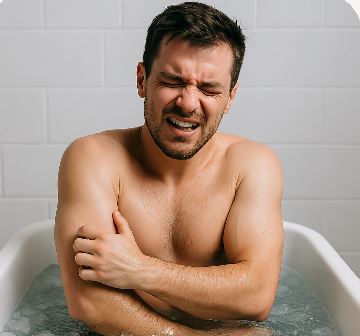
Why Cold Therapy Helps Joints but Cold Days Doesn't?
❄️ Why Cold Therapy Helps Joints
Cold plunges and ice showers are a form of targeted, short-duration cold exposure designed to:
- Reduce inflammation by constricting blood vessels (vasoconstriction)
- Numb nerve endings, reducing pain perception
- Lower metabolic activity in tissues, slowing inflammatory processes
- Trigger hormonal responses (like norepinephrine) that reduce pain and improve mood
This is why athletes and people with arthritis often feel relief after a cold plunge or ice shower—the exposure is brief, intense, and followed by rewarming, which promotes circulation and healing.
🌬️ Why Cold Weather Can Make Joints Ache
Cold weather, on the other hand, is passive, prolonged, and often uncontrolled. According to Healthline and Medical News Today, here’s why it can worsen joint pain:
- Reduced blood flow: Cold causes vasoconstriction, which limits circulation to extremities and joints.
- Thicker synovial fluid: Cold temperatures increase the viscosity of joint fluid, making movement stiffer and more painful.
- Barometric pressure changes: Drops in pressure can cause tissues to expand slightly, increasing joint discomfort.
- Reduced activity: People tend to move less in cold weather, which leads to stiffness and muscle tightness.
- Mood effects: Cold, gloomy weather can lower mood, which in turn increases pain sensitivity.
🧬 Summary Table
|
Factor |
Cold Plunge / Ice Shower |
Cold Weather |
|---|---|---|
|
Duration |
Short (1–10 min) |
Prolonged (hours to days) |
|
Control |
Intentional, targeted |
Passive, ambient |
|
Effect on Inflammation |
Reduces inflammation |
May increase stiffness |
|
Circulation |
Rebound vasodilation after exposure |
Sustained vasoconstriction |
|
Pain Relief |
Yes, via endorphins and nerve desensitization |
Often worsens pain |
|
Mood Impact |
Uplifting (dopamine, norepinephrine) |
Can lower mood and increase pain perception |
🧠 Final Thought:
Cold therapy works because it’s brief, intense, and followed by recovery. Cold weather hurts because it’s long, passive, and often paired with inactivity. So while both involve low temperatures, the context and control make all the difference.
Would you like a guide on how to safely use cold therapy for joint pain or inflammation "Click Here"
